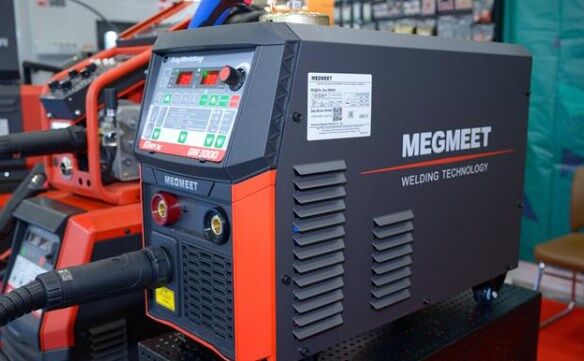Adjusting a welding machine correctly is crucial for achieving high-quality welds. Whether you're a novice or an experienced welder, understanding how to fine-tune your equipment can significantly impact the outcome of your work. In this article, we explore the three best ways to adjust a welding machine to ensure optimal performance and superior weld quality.

I. Adjusting the Voltage and Amperage
1) Introduction to Voltage and Amperage:
Voltage and amperage are two fundamental settings that need precise adjustment for different welding tasks. Voltage controls the arc length, while amperage determines the heat input and penetration.
2) Steps to Adjust Voltage and Amperage:
Identify the Material and Thickness: The material type and thickness you are welding will dictate the appropriate voltage and amperage settings.
Refer to a Welding Chart: Most welding machines come with a chart or manual indicating recommended settings for various materials and thicknesses.
Adjust the Voltage: Set the voltage according to the chart. For thinner materials, lower voltage settings are generally preferred, while thicker materials require higher voltage.
Set the Amperage: Adjust the amperage based on the material thickness and the type of weld. Higher amperage is needed for deeper penetration, while lower amperage suits thinner materials to avoid burn-through.
Test and Fine-Tune: Perform a test weld on a scrap piece of the same material. Inspect the weld bead and make fine adjustments to achieve the desired quality.
3) Tips for Optimal Settings:
Consistency: Ensure your settings remain consistent for similar materials and tasks.
Monitor: Regularly monitor the weld quality and adjust as needed.
Documentation: Keep a record of successful settings for future reference.
II. Adjusting the Wire Feed Speed (for MIG Welding)
1) Importance of Wire Feed Speed:
In MIG welding, the wire feed speed controls the amount of filler material supplied to the weld. Proper adjustment ensures a stable arc and consistent weld bead.
2) Steps to Adjust Wire Feed Speed:
Set the Voltage: Adjust the voltage first, as it influences the wire feed speed requirements.
Adjust the Wire Feed Speed: Start with the recommended settings from the machine’s manual or chart.
Perform a Test Weld: Conduct a test weld and observe the weld bead.
Fine-tune the Speed: Adjust the wire feed speed to eliminate issues like bird nesting (too high) or inconsistent arc (too low).
Optimize: Aim for a smooth and consistent bead. The wire should feed steadily without skipping or surging.
3) Tips for Wire Feed Speed:
Matching Speed and Voltage: Ensure the wire feed speed matches the voltage settings to maintain a stable arc.
Consistency: Maintain consistent speed for similar tasks to ensure uniform welds.
Monitor: Regularly check the weld quality and make necessary adjustments.
III. Adjusting Gas Flow Rate
1) Role of Shielding Gas:
Shielding gas protects the weld pool from contamination. The flow rate must be adjusted correctly to ensure optimal shielding without wastage.
2) Steps to Adjust Gas Flow Rate:
Select the Right Gas: Choose the appropriate shielding gas for your welding process and material.
Set the Regulator: Adjust the regulator to the recommended flow rate. Common rates range from 15 to 25 cubic feet per hour (CFH) for MIG and TIG welding.
Test the Flow: Activate the gas flow and check the rate using a flow meter.
Perform a Test Weld: Conduct a test weld to ensure proper shielding. Look for a smooth, contaminant-free weld bead.
Adjust as Needed: Fine-tune the flow rate if you notice issues like porosity (too low) or excessive gas usage (too high).
3) Tips for Gas Flow Adjustment:
Avoid Drafts: Ensure the welding area is free from drafts that can disrupt gas flow.
Monitor: Regularly check the gas flow and adjust if necessary.
Efficiency: Use the minimum effective flow rate to save gas and reduce costs.
IV. Conclusion
Properly adjusting your welding machine is essential for achieving high-quality welds and efficient operation. By focusing on voltage and amperage, wire feed speed, and gas flow rate, you can ensure optimal performance and consistent results. Whether you're working with MIG, TIG, or stick welding, these adjustments are key to your success.
At Megmeet Welding Technology, we are dedicated to providing advanced welding solutions and expert advice. For more tips, tools, and equipment, visit our website and discover how we can help you achieve your welding goals.
Related articles:
1. How to Adjust the Current and Voltage of MIG Welding? 2 Methods for Precise and Fast Adjustment!
2. 3 Easy Ways to Adjust Your Welding Machine
3. How to Improve Robotic Welding Performance?
4. How To Weld Stainless Steel – MIG, TIG and MMA Welding
5. How To Clean Stainless Steel Welds After Welding? [Easiest Way]




